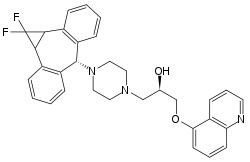Zosuquidar
Zosuquidar (also LY-335979) is an experimental antineoplastic drug. In 2010, it was announced that a phase III trial for the treatment of acute myeloid leukemia (AML) and myelodysplastic syndrome did not meet its primary endpoint[1] and Eli Lilly discontinued its development.
 | |
| Clinical data | |
|---|---|
| ATC code |
|
| Identifiers | |
IUPAC name
| |
| CAS Number | |
| PubChem CID | |
| ChemSpider | |
| UNII | |
| KEGG | |
| ChEMBL | |
| CompTox Dashboard (EPA) | |
| ECHA InfoCard | 100.236.552 |
| Chemical and physical data | |
| Formula | C32H31F2N3O2 |
| Molar mass | 527.61 g/mol g·mol−1 |
| 3D model (JSmol) | |
SMILES
| |
InChI
| |
| | |
Zosquidir inhibits P-glycoproteins. Other drugs with this mechanism include tariquidar and laniquidar. P-glycoproteins are trans-membrane proteins that pump foreign substances out of cells in an ATP dependent fashion. Cancers overexpressing P-glycoproteins are able to pump out therapeutic molecules before they are able to reach their target, effectively making the cancer multi-drug resistant. Zosuquidar inhibits P-glycoproteins, inhibiting the efflux pump and restoring sensitivity to chemotherapeutic agents.
Zosuqidar was initially characterized by Syntex Corporation, which was acquired by Roche in 1990. Roche licensed the drug to Eli Lilly in 1997. It was granted orphan drug status by the FDA in 2006 for AML.